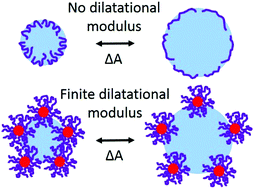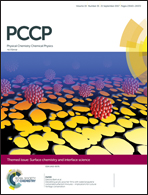Enhanced interfacial activity of multi-arm poly(ethylene oxide) star polymers relative to linear poly(ethylene oxide) at fluid interfaces†
Abstract
Interfacial tension reduction, dynamic dilatational elasticity and extent of adsorption were investigated for linear poly(ethylene oxide) (PEO) chains of varying molecular weight and for PEO star polymers with an average of 64 arms per star at air/water, xylene/water, and cyclohexane/water interfaces. Adsorption on planar interfaces was monitored by ellipsometry, while interfacial tension and dilatational elasticity were measured separately by pendant drop tensiometry. Previously reported to be efficient emulsifiers, PEO stars are shown here to also be more effective foaming agents than linear PEO. Accordingly, PEO stars adsorb to a greater extent and produce larger interfacial tension reduction and greater dynamic dilatational moduli than linear PEO. The more extensive adsorption and greater interfacial tension reduction for PEO stars are attributed to their compactness. More mass is introduced per unit area of interface, and more interfacial penetration is achieved, upon their adsorption than for adsorption of linear polymers that adopt the conformation of loops, trains and tails. Whereas cyclohexane is a non-solvent for PEO, xylene is a good solvent. Dispersing PEO stars in the xylene phase yields greater interfacial tension reduction at the xylene/water interface than occurs when initially dispersing PEO stars in the aqueous phase. In contrast, the interfacial tension for linear PEO shows no dependence on the phase from which it adsorbs. Ellipsometry confirms the path-dependent extent of adsorption to the xylene/water interface, but also reveals additional complexity. When adsorbing from xylene, thick interfacial films result that likely contain dispersed water, as suggested by the observation of spontaneous water-in-xylene emulsification when PEO stars are initially dispersed in xylene. This is tentatively attributed to shear provided by Marangoni flow. Spontaneous emulsification occurs only when PEO stars are initially dispersed in the xylene phase. Linear PEO produces neither thick interfacial films nor spontaneous emulsification.

- This article is part of the themed collection: Surface chemistry and interface science


 Please wait while we load your content...
Please wait while we load your content...